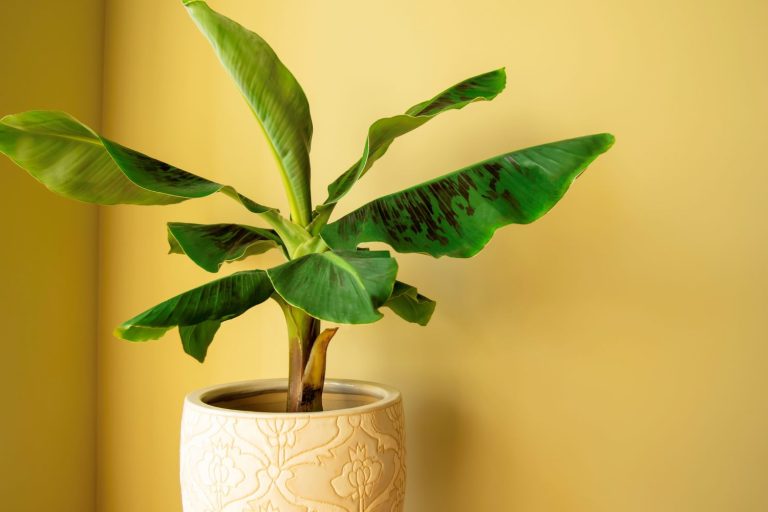When you think about adding some greenery to your home, growing an indoor banana tree probably isn't the first thing that comes to mind. Elephant ears, Monstera, and Sansevieria may already have a place in your home and heart, but there's always room for more.
Banana trees add a tropical touch to any room with their large, glossy leaves. But don't expect them to decorate your living room. When grown indoors, banana trees rarely produce fruit, so make sure you have a large planter and some space. Bananas are sure to become a new favorite in your houseplant collection.
Best Banana Varieties to Grow Indoors
You're probably most familiar with the Cavendish banana variety, the type sold in supermarkets across the United States. Its typical yellow fruit is what we use as our go-to snack and smoothie ingredient. But not all banana skins are yellow. Blue Java bananas have turquoise skin, while red bananas have a deep wine red skin. In the wild, banana trees can easily reach heights of 20-40 feet. Their red or purple flowers eventually produce the bunches of bananas we commonly see in grocery stores.
If you're growing a banana tree indoors, keep an eye on space: banana trees can grow very tall, so a traditional Cavendish isn't suitable; instead, look for dwarf varieties of banana trees; these are best grown as houseplants.
Dwarf Cavendish (Tropicana) grows to a height of 8 to 10 feet. Dwarf Red grows to a height of 6 feet. Veranda grows to a height of 10 feet.
If you're thinking about growing a banana tree indoors from a store-bought fruit, be aware that these bananas have been bred to be seedless; otherwise, they would develop large, hard seeds inside the fruit that would make the banana practically inedible. The downside is that Cavendish bananas are all clones, or genetic copies of each other, so they are all susceptible to disease, and disease can quickly spread to all of them. The best way to grow a banana tree indoors is to buy it from a reputable seller.
How to Grow Bananas Indoors
Potting
Provide your banana with a pot that is approximately twice the size of the plant's root system. Make sure the container has drainage holes. Fill the container with fresh potting soil. Do not cover the leaf layer on the stem with soil.
Light
Native to tropical regions near the equator, banana trees need lots of sunlight. “Outdoors, bananas thrive in direct sunlight,” says horticulturist Justin Hancock of Costa Farms. “So indoors, you need to provide as much light as you can, whether that's natural light, artificial light, or a combination of both. You need to make sure your banana tree can be in strong shade for the majority of the day.” Purchasing a grow lamp can help keep your banana tree healthy through the winter.
“Banana trees do best in areas that get at least six hours of direct sunlight, which means they should be placed near a south- or west-facing window,” says Lindsay Pangborn, horticulture expert at Bloomscape.
Temperature and Humidity
Banana trees prefer a warm, moist environment. They can grow in US zones 9-11. Indoor banana trees should be kept at a temperature between 67-90°F; any lower temperature will stop them from growing. Banana trees grow fastest in temperatures between 80-95°F. With plenty of water, banana trees can tolerate higher temperatures, but they do not like them.
“Banana trees live in humid environments and may show signs of stress if the air in your home becomes too dry,” says Pangborn. “Protect the plant from drafty areas and draughts and increase humidity by placing a tray of pebbles or a humidifier nearby.”
water
Indoor banana trees should be watered frequently to keep the soil moist, but not soggy; if left waterlogged, the plant can develop root rot.
fertilizer
Banana houseplants require frequent fertilization. Fertilize often with the right amount of fertilizer. Aim to fertilize your banana plant once a month. For best results, use a balanced, water-soluble fertilizer spread evenly throughout the pot.
Repotting
If you want your banana tree to grow big, get a big pot. Banana trees grow to suit the size of their environment. The best time to repot a banana tree is in the spring before the active growing season begins. Banana trees are not fussy plants that need to be repotted frequently. They don't mind a little root congestion. As a rule of thumb, banana trees should be repotted every 3 years.
Pests and Problems
The most common problem with indoor bananas is root rot caused by overwatering. Don't leave bananas submerged in water. Banana leaves can become susceptible to diseases such as powdery mildew. High humidity and poor ventilation can cause these diseases to appear suddenly. Cut off affected leaves and gently fan the plant with a fan until the problem is resolved.
Keep an eye out for spider mites. These tiny, nearly transparent pests usually hide on the undersides of leaves. The telltale signs are yellow bumps and cottony spider webs with tiny dots (mites). To get rid of spider mites, use a mixture of 1 part rubbing alcohol and 4 parts water (for example, 1/2 cup rubbing alcohol and 2 cups water). Wipe or spray the plant's leaves with this mixture.
Over time, dust, dirt and debris will accumulate on the leaves of your banana tree. A quick wipe down will help keep your plant healthy and looking great. Wipe the leaves of your plant with a clean, soft cloth about once a month.
Growing tropical plants and fruit trees indoors
Besides banana trees, there are many tropical plants and fruits that you can grow indoors. Our guide to growing fruit trees indoors will tell you what you need to know about your indoor garden and which plants to choose. Grow tropical plants for colorful flowers or grow indoor ferns for simple greenery. Add an orchid or two for an exotic feel.

